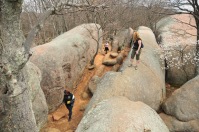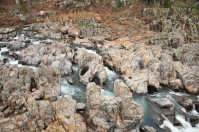Agriculture News
WKU group visits Ozarks to study geomorphology, karst environments, water resources
- Tuesday, May 12th, 2015
A group of 15 students in three WKU Geography and Geology courses headed to the Ozarks last month to participate in an interdisciplinary fieldtrip focused on geomorphology, karst environments and water resources. The group visited various landscapes that included the St. Francois Mountains and Salem Plateau areas of southeastern Missouri and the northern Arkansas karst region as part of collection of Spring 2015 courses taught by Dr. Jason Polk and Dr. Leslie North.
The purpose of the trip was to engage students in the field to learn about fluvial, glacial, climatic and karst geomorphological processes and landforms, as well as karst landscapes and cave formation, and the water resource implications in these types of settings. The trip provided them with hands-on experience in studying and understanding these complex topics in a region that provides a natural classroom with diverse examples of geomorphology from 1.4 billion years of Earth’s history, intense karst features, including some of the largest springs in the country, and tourism and public health issues derived from water resource challenges.
The group visited several distinct regions to gain a comparative understanding of various natural processes and landforms. One major theme was visiting the karst region of the Salem Plateau, which formed in sedimentary rocks, to examine fluvial (river) and karst processes, as well as water resource issues. The stops included Missouri’s largest spring (Big Spring in Van Buren), several smaller springs, and a visit to Grand Gulf State Park, which was flooded completely from recent heavy rainfalls- this was one of the rare times in many years that the water was at such a high level and a treat for the students to experience the groundwater action at work. The group discussed the implications for contaminants in the groundwater, as Grand Gulf’s water eventually exits at Mammoth Spring in Arkansas, another stop the group made to study the effects of the hydroelectric dam and artificial barriers built around the spring boil.
The group also hiked through the Pickle Springs Natural Area to see arches and canyons that formed in sedimentary sandstone bedrock, as well as making a comparison to it with the igneous geomorphology caused by volcanic and tectonic activity nearby. Stops to observe that type of landscape included several “shut-ins,” or constricted areas, that occur in streams when the harder igneous rock erodes away more slowly than surrounding rocks. The most spectacular of these in the area is Johnson Shut-Ins, which is formed from three different types of igneous rock, including ash fall, ash flow, and rhyolite, a fairly unique combination for the area. The students also visited Taum Sauk Mountain, the highest point in Missouri, to learn about igneous glades and observe lichens, frost wedging and other erosive processes. For many students, a favorite stop was Elephant Rocks State Park to observe a large granitic exfoliation dome where elephant-size rocks remain after millions of years of erosion and weathering has rounded them out as they erode along weaknesses in the rock caused by “unloading” when pressure is released through tectonic uplift.
The group ended its trip in Arkansas with a visit to Blanchard Springs and Blanchard Springs Caverns, one of the country’s most decorated and large showcaves. The students studied the karst geology, hydrologic implications for water resources and cave forming processes, and also learned about resource management and some of the other interesting exploration and surveying conducted during the cave’s history.
Bowling Green Geology major Brittany Sale said: “It was very interesting to see how the driving and resisting forces created these vast landscapes and landforms.”
Part of the course emphasis is to understand the linkages between the cause-and-effect relationships that occur in the landscape. Undergraduate Cody Meservy of Jasper, Indiana, noted: “Experience out in the field is merely one aspect of learning something as complex as geomorphology; however, in certain fields of study, like geomorphology, it is a necessity in order to gain a full understanding of the subject matter.”
The fieldtrip’s goal is to bring the natural environment into perspective for the students and provide hands-on, practical application of what is learned in the classroom. Isaac Hardesty of Philpot “was able to visualize how complex karst systems are and how big their drainage basins can be…,” in reference to the major springs visited in the Ozarks.
Other students who participated in the trip included undergraduates Chelsea Ballard of Horse Cave; Caleb Koostra of Lewisburg; Ilea Schneider of Lewisport; Kristen Coomer of Union; Erin McWilliams of Albany; Jos Hendrikse of Westkapelle, Netherlands; Paulina Littlefield of Rexburg, Idaho; Kasey Jordan of Bowling Green; and graduate students Bo Schaefer of Cecilia; Steven Devine of Hopkinsville; Indu Bhattrai of Katmandu, Nepal; and Sarah Fielden of Louisville.
“Leading a combined fieldtrip with students from multiple courses provides an opportunity for interdisciplinary learning and challenges the students to view natural features and processes from different perspectives,” Dr. Polk said. “The students were highly engaged in the trip, as the Ozarks provides a plethora of sites to learn all about geomorphic processes, karst environments, and water resource issues. These types of experiences provide students with the opportunity to more deeply understand the physical and social processes that shape our environment.”
Geography and Geology Department Head Dr. David Keeling noted that “the department has long considered regular field excursions essential to meeting learning objectives, as there is no substitute for field experience in the geosciences. Students have the opportunity to put into practice the observation and analytical skills learned in the classroom.”
Contact: Jason Polk at jason.polk@wku.edu or (270) 745-5015
Some of the links on this page may require additional software to view.






